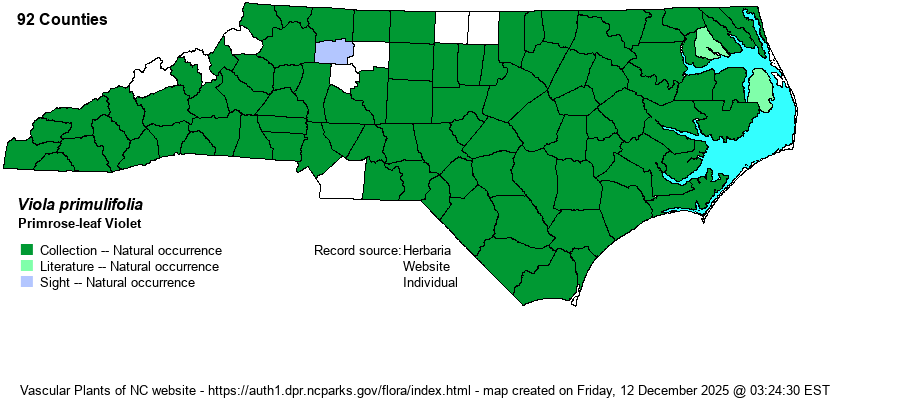| Author | L. | |
| Distribution | Throughout the state, and one of the few violets that likely occur in all 100 counties.
This species has an Eastern range. It ranges across eastern Canada, and south to southern FL and eastern TX. However, it is scarce in the Great Lakes and Mideastern states.
| |
| Abundance | Common in the Coastal Plain; fairly common to frequent in the Piedmont; fairly common in the Mountains, though scarce in higher elevations. | |
| Habitat | This is a wetland species of sunny to partly sunny habitats. It grows in ditches, openings in bottomlands and swamps, marsh edges, pond and lake margins (and exposed bottoms), bogs, wetter spots in savannas, and other damp ground. | |
| Phenology | Blooms from March to May, and fruits shortly after flowering. | |
| Identification | This is one of only a few acaulescent (no leaves on the flowering stalk), white-flowered violets in the state, and is by far the most common across the state. Its flowering stalk only reaches about 3-4 inches tall, and the multiple basal leaves are ovate to oblong in shape, with cuneate to truncate leaf bases. Each blade is about 2 inches long and about 1-inch wide. The white flowers are small and similar to others in the genus. The only other similar species is V. lanceolata, which has lanceolate to linear leaves, 3-8 times longer than wide, as opposed to about 1.5-2 times longer than wide in V. primulifolia. Both species can grow near each other, in similar wet places, in the Coastal Plain, and thus take some care in the identification, though normally there is little trouble. V. primulifolia is so widespread, with so many habitats, that it is hard to look for it specifically, and most observers simply run across it in routine field work. | |
| Taxonomic Comments | None
General note on Viola: In 2009-10 B.A. Sorrie (website map editor) went through the whole collection at NCU, annotating all specimens against those verified by experts in the genus. The range maps in RAB (1968) have been changed accordingly. More recently, Harvey Ballard and colleagues are in the process of revising all Eastern and Southeastern Viola, and have annotated all specimens at NCU in July 2024. They recognize additional species not in RAB or in previous editions of Weakley et al.; we will follow updated editions of Weakley et al. in recognizing them. Species range maps have been adjusted to account for identification changes. | |
| Other Common Name(s) | None | |
| State Rank | S5 | |
| Global Rank | G5 | |
| State Status | | |
| US Status | | |
| USACE-agcp | FACW link |
| USACE-emp | FAC link |

